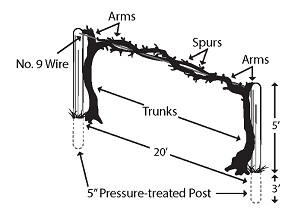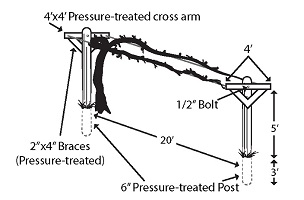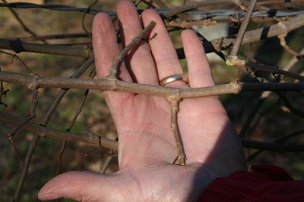From
the University of Georgia Cooperative Extension
College
of Agriculture and Environmental Sciences
Muscadine
Grape Trellis Systems
Excerpts from the Home Garden Muscadine Grapes
publication
Muscadines
will require a minimum 20 feet of trellis per plant. Therefore, measure
the area where you will plant the vines. That way, you will know how
many plants to purchase. If you plan to have more than one row, space
the rows 12 feet apart. Once you have determined how many plants to
buy, lay out the area by putting stakes where the trellis posts will
go. The posts should be 20 feet apart. Plant the muscadines 1 foot from
the post since the crop load is usually heaviest in the center of the
vine.
The one wire
trellis
(Fig. 1) and the double curtain trellis (Fig. 2) are the two most
common trellises used by backyard gardeners. The one wire trellis is
easier to construct, but yields are greater from the double curtain. If
space is limited, the double curtain should be used to maximize
production.

Fig. 1 
A one wire trellis with established vine.
One
Wire Trellis - Use the single wire trellis system in south Georgia
because of fruit disease problems. End posts should be 5- or 6-inch
pressure-treated, 8-foot posts. Set them 3 feet deep and angle them
slightly away from each other. Line post(s) should be 4 inches in
diameter and 7 feet long. Set them 2 feet deep in a vertical position.
Use no. 9 wire to support the vines. Wrap the trellis wire around one
end post near the top. Staple it securely several times. Then run it
across the top of the end post and staple it loosely. Next, run the
wire over the tops of the line posts. Staple the wire loosely to the
tops of these posts. Staple the wire loosely to the top of the other
end post. Then, pull the wire tight. Wrap it around the end post and
staple it tightly several times. The wire should be 5 feet above and
parallel to the ground.
Double
Curtain Trellis
- The double curtain trellis provides two wires 4 feet apart and 5 feet
above ground. This permits each vine to produce 40 feet of fruiting arm
rather than the conventional 20 feet with the one wire system.
Figure
2 is an example of a double curtain trellis made with pressure treated
wood. Four-inch galvanized pipe welded to form the "T" shaped end posts
can also be used. Regardless of the materials used. Regardless of the
materials used, they should conform closely to the specifications shown
in Fig. 2. The wires should be parallel to the ground.

Fig.
2 
A double curtain trellis with established vines
Diligent
care during the two growing seasons following planting is essential if
the vines are to develop into productive additions to the home garden.
Vines generally die the year of planting if particular attention isn’t
given them. Watering as needed, fertilizing as recommended, keeping the
area around the young plants weed free, and proper training must be
done if success is to be realized.
A properly trained vine has a
trunk, two (or four) arms and fruiting spurs. The first two years of
training are devoted to developing the permanent trunk and fruiting
arms.
In the spring following planting, each plant will produce
three or four shoots. When these shoots are about 1 foot long, select
the strongest and remove all the others. Tie a string to a small stake.
Drive the stake in the ground. Place it about 3 inches from the plant.
For
the One Wire Trellis, do the following: Tie the free end of the string
to the trellis wire. Train the shoot to the string. Pinch off side
shoots as they develop. When the shoot reaches the top wire, pinch it
off just below the wire. Let the top two buds form the two arms along
the trellis wire.
For the Double Curtain Trellis, do the
following: Immediately above the young vine, tie a piece of string
between the two wires. Then tie the free end of the string attached to
the stake to the middle of the string connecting the two wires. The two
strings should form a “Y.” Train the shoot to the string. When the
shoot reaches the string connected to the two wires, pinch out the tip.
Let the top two buds develop. Train these shoots to the strings leading
to the trellis wire. Once they reach the wire, pinch out the tips and
let the top two buds form the two arms along the trellis wire.
For
either trellis system, shoots other than the arms growing from the
trunk should be kept pinched back. Once the trunk and arms have
developed, the vine is ready to begin fruiting. Shoots (also called
canes) will grow each year from the young arms.
Since muscadine
fruit are borne on new shoots arising from last year’s growth, you
should prune back the canes that grew the previous year, leaving about
3 inches of growth to form spurs. Prune in February or early March.
Don’t be alarmed if the vines “bleed” at pruning cuts. Bleeding does
not harm the vines.
When you leave too many buds on the vine,
the plant over produces and fruit are poor. After three or four years
of production, you will need to remove every other spur cluster to
prevent overcrowding. Try to leave spurs that are on the top of the
arms (Fig. 3). It is a good idea to remove old fruit stems since they
are a source of disease.
Remove tendrils that wrap around the
arms or spurs. (Tendrils are finger-like plant parts muscadines use to
attach themselves to their supporting structure.) If tendrils are not
removed, they will girdle the arms or spurs and cause reduced
production. Remove old fruit stems if fruit rots are a problem since
the disease may overwinter in the old stems.

Fig. 3
Example of spurs
Further Reading
Home Garden Muscadine Grapes,
University of Georgia, Cooperative Extension pdf 8 pages
Back
to
Muscadine Grape
Page
Pruning and
Training Page
|
|
Bibliography
Krewer, Gerard. "Home Garden Muscadine Grapes." University of Georgia,
Cooperative Extension, extension.uga.edu/publications/detail.html?number=C949&title=Home%20Garden%20Muscadines#Constructing.
Accessed 8 Oct. 2018.
Photographs
Fig. 1,2,3 University of Georgia,
Cooperative Extension, extension.uga.edu/publications/detail.html?number=C949&title=Home%20Garden%20Muscadines#Constructing.
Accessed 8 Oct. 2018.
Published 8 Oct. 2018 LR
|



